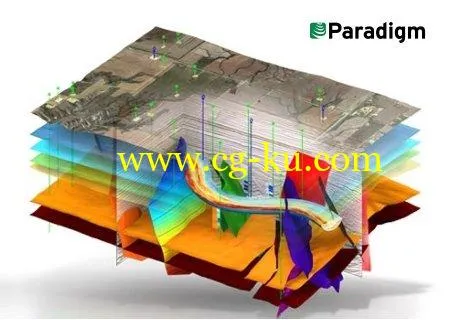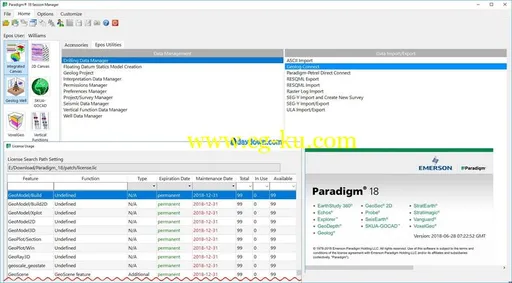Emerson Paradigm 18 build 2018.06.28 | 2.5 GbEmerson’s E&P Software Solutions announced the release of Paradigm 18.
This release includes new applications for advanced automation using machine learning methods, enhanced integration across the full range of Paradigm solutions, more effective collaboration with support for applications running on the Cloud, and optimization of processes and workflows that improve image and earth model accuracy.
What’s new in this release – Date July 9, 2018:New for InterpretersParadigm 18 uses machine learning as a data integrator and process automation tool, and introduces new solutions for the unsupervised classification of pre- and poststack seismic data.
Geobody detection has been integrated into the SeisEarth interpretation suite and can be applied to the results of the seismic facies classification.
A new parameter sensitivity analysis facilitates user understanding of the impact of parameter changes on several interpretation workflows.
Further enhancements have been made to the Integrated Canvas released in Paradigm 17, that consolidates the core SeisEarth interpretation windows into a single application.
The Integrated Canvas is complemented with new high-resolution workflows for interval seismic attributes, Spectral Decomposition and Dip-steered enhancement attributes.
Paradigm 18 introduces a ‘Stratigraphic Context’ for a variety of interpretation activities.
This new functionality allows the versioning of sets of database entities, associated with well selection and stratigraphic assignment within the same Epos Project.
Paradigm 18 enhances the user experience of cross-discipline teamsIntegration between interpretation and modeling applications has been extended in Paradigm 18.
The main interpretation windows now share a common user interface with the SKUA-GOCAD modeling solution, for more efficient work.
Time-based production data loaded in Epos may now be accessed by StratEarth and SKUA-GOCAD, enabling a more comprehensive analysis of this data within the interpretation framework.
StratEarth is also available in the same Window used by the BaseMap, 3D Canvas and Section windows, to improve the experience of geologists working in the Epos environment.
Paradigm Quantitative Seismic Interpretation now includes automatic parameter optimization at all well locations for seismic inversion and AVO(A) activities.
Crossplot overlays may be created and displayed in the crossplot utility.
Users can also access the crossplot overlay from the Epos database or from Geolog.
New for Geologists and PetrophysicistsA significant upgrade to Geolog 18 is the generalization of petrophysical uncertainty, which enables most Geolog modules and Loglans to run in Monte Carlo mode.
Other updates include a new customized reporting module, a Formation Testing methodology, and major updates to the geomechanics, engineering, and production modules, including a new cement evaluation functionality.
Python programming support is enabled inside of Geolog Loglan.
New for GeomodelersSKUA-GOCAD modeling workflows have been optimized to handle large numbers of wells.
Additional functionality for unflattening interpretation data and seismic volumes has been added to better benefit from SKUA-GOCAD paleospace.
Gridless geostatistics have been added for stratigraphically constrained property modeling on unstructured grids and meshless objects.
The release upgrades its support for geomechanical workflows with hybrid grids that combine the benefits of structured and unstructured grids, in support of both flow simulation and geomechanical simulation workflows.
New for Seismic Processors and ImagersFor GeoDepth velocity model building users, tomography updates include support for large datasets in conjunction with high-resolution tomographic update grids.
This leads to a substantial reduction in memory consumption and project run times, while resulting in more accurate velocity models.
2018-05-13_14-21-55The integration between GeoDepth and SKUA has been further strengthened by enhancements to GeoDepth 3D structural model-based tomography, made to support geologically-constrained velocity models that honor faults and multi-valued surfaces.
Additionally, a time-preserving tomography workflow supports complex models, facilitating the minimization of mis-ties between well markers and the structural model in depth.
GeoDepth users will enjoy productivity improvements when performing velocity model updating and imaging of multi-line 2D projects, including a new 2D Kirchhoff depth migration and 2D illumination studies.
A new orthorhombic workflow is now available for output from EarthStudy 360® Imager, enabling more accurate estimation of fracture orientation and stress.
New features for users of Echos seismic processing include a method for model-based ground roll modeling and attenuation, new residual statics applications, and an alternative method for 5D data reconstruction based on Radon Transform data modeling.
New tools leverage modern workstations for the display, analysis, QC and manipulation of seismic survey geometry information.
And new seismic file parallel I/O capabilities provide improved throughput for seismic processing and imaging workflows.
Improved Data Sharing and ConnectorsParadigm customers can now use cloud hosting to access our products, allowing remote teams to work together more efficiently.
Access to Web-based Open Source and GIS data sources has been extended.
A new mechanism that allows the automatic distribution of ‘approved’ support packs to all Windows users of our applications offers significant benefits to large deployments.
This release offers very high levels of prestack seismic data compression, with no significant degradation of the seismic data signal.
Product:Emerson ParadigmVersion:18 build 2018.06.28Supported Architectures:x64Language:englishSystem Requirements:PCSupported Operating Systems:Windows 7even or newerSize:2.5 Gb

